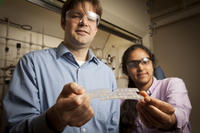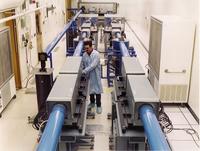-
Environmental group sues State Department for Keystone XL-related files
The Sierra Club has announced it is suing the State Department for files related to an environmental review draft of the Keystone XL pipeline. The group tried to gain access to the files through the Freedom of Information Act, but the request was denied, so the group filed the suit on Monday in the U.S. District Court in the Northern District of California.
-
-
TSA’s behavior detection program not cost effective: DHS IG

DHS Inspector General (IG) has released a 41-page report last week stating that the Transportation Security Administration (TSA) cannot ensure that its behavior detection program, known as the Screening of Passengers by Observation Techniques (SPOT) is objective or cost-effective.
-
-
Making jet fuel from switchgrass

The Energy Department’s National Renewable Energy Laboratory (NREL) is partnering with Cobalt Technologies, U.S. Navy, and Show Me Energy Cooperative to demonstrate that jet fuel can be made economically and in large quantities from a renewable biomass feedstock such as switch grass. The project could spur jobs in rural America, lead to less reliance of foreign oil.
-
-
Fighting effectively without committing war crimes
Combat troops must minimize the humanness of their enemies in order to kill them. They cannot be effective fighters if they are distracted by feelings of empathy for opponents. Indifference to the enemy, rather than loathing, however, may help prevent war crimes and provide troops with a better path back to healthy civilian lives, researchers say.
-
-
Studying rare Earth elements in Alaska may help make them less rare
A unique deposit of heavy rare Earth elements (REE) at Alaska’s Bokan Mountain could help scientists understand how rare Earth element deposits form, according to new research. Rare Earth elements are important, but scarce, elements used in components in many cutting edge electronic and defense technologies.
-
-
Better weather predictions for the U.S. Navy
In a development that should significantly affect fleet operations, the U.S. Navy has adopted a new global weather forecasting model. The Naval Global Environmental Model (NAVGEM)could inform Navy operations for years to come. It is particularly important as U.S. fleet presence increases throughout the Asia-Pacific region, known for intense weather events like typhoons.
-
-
Highly sensitive polymer detects IEDs

A chemical which is often the key ingredient in improvised explosive devices (IEDs) can be quickly and safely detected in trace amounts by a new polymer created by a team of Cornell University chemists. The polymer, which potentially could be used in low-cost, handheld explosive detectors and could supplement or replace bomb-sniffing dogs.
-
-
Protecting and climate proofing Europe’s coast
The coastline of EU member states extends over 17,000 kilometers. It is home to seventy million inhabitants. The estimated value of the assets within 500 meters from the coast rises to a staggering 1,000 billion Euros. An EU-funded science and engineering initiative is gathering all relevant scientific knowledge to develop a systematic approach to deliver a safe, natural, and climate-proof European coast.
-
-
Laser-driven neutrons to detect nuclear smuggling

Researchers have successfully demonstrated for the first time that laser-generated neutrons can be enlisted as a useful tool in the war on terror, as Los Alamos shows first nuclear material detection by single short-pulse-laser-driven neutron source.
-
-
Students control a helicopter in flight using only brain waves
A remote controlled helicopter has been flown through a series of hoops around a college gymnasium in Minnesota. It sounds like your everyday student project; but there is one caveat: the helicopter was controlled using just the power of thought. The helicopter was controlled by a noninvasive technique called electroencephalography (EEG), which recorded the electrical activity of the students’ brains through a cap fitted with sixty-four electrodes.
-
-
U.S. unlikely to meet its biofuel goals

The Energy Independence and Security Act of 2007 (EISA) mandates that by 2022 the United States derive fifteen billion gallons per year of ethanol from corn to blend with conventional motor fuels. A new study says that if the climate continues to evolve as predicted by the Intergovernmental Panel on Climate Change, the United States stands little to no chance of satisfying its biofuel goals.
-
-
Wildfires in west, southwest forcing hundreds from their homes
The arrival of summer has typically been accompanied by an increase in the number and intensity of wild fires in the U.S. southwest, and this year is no exception.
-
-
Science Academies highlight role of science in meeting global challenges
Science academies from around the globe issued joint statements last week to call world leaders’ attention to the role science, technology, and innovation can play in the pursuit of sustainable development, and to raise their awareness of the emerging threat of drug resistance in infectious agents including tuberculosis. The “G-Science” statements are intended to inform government leaders attending next month’s G8 Summit and other international gatherings later this year.
-
-
California Democratic lawmakers want a go-slow approach to fracking
California may be on the verge of an oil rush. It is estimated that hydraulic fracturing, or fracking, at the Monterey Shale formation may tap reserves of fifteen billion barrels of oil. Democratic lawmakers do not see it that way, and have proposed numerous anti-fracking bills aiming to control the use of the controversial technology. Ten bills have been tabled so far, and more are on the way.
-
-
Laser weapons on ships require reliable shipboard power
For the first time, a laser weapon system (LaWS) will be placed onboard a deployed ship, USS Ponce, for testing in the Persian Gulf in 2014. The U.S. Navy’s plan to put laser weapons on ships, makes the need for reliable, high-voltage shipboard power a matter of national security.
-
More headlines
The long view
New Technology is Keeping the Skies Safe
DHS S&T Baggage, Cargo, and People Screening (BCP) Program develops state-of-the-art screening solutions to help secure airspace, communities, and borders
Factories First: Winning the Drone War Before It Starts
Wars are won by factories before they are won on the battlefield,Martin C. Feldmann writes, noting that the United States lacks the manufacturing depth for the coming drone age. Rectifying this situation “will take far more than procurement tweaks,” Feldmann writes. “It demands a national-level, wartime-scale industrial mobilization.”
How Artificial General Intelligence Could Affect the Rise and Fall of Nations
Visions for potential AGI futures: A new report from RAND aims to stimulate thinking among policymakers about possible impacts of the development of artificial general intelligence (AGI) on geopolitics and the world order.
Smaller Nuclear Reactors Spark Renewed Interest in a Once-Shunned Energy Source
In the past two years, half the states have taken action to promote nuclear power, from creating nuclear task forces to integrating nuclear into long-term energy plans.
Keeping the Lights on with Nuclear Waste: Radiochemistry Transforms Nuclear Waste into Strategic Materials
How UNLV radiochemistry is pioneering the future of energy in the Southwest by salvaging strategic materials from nuclear dumps –and making it safe.
Model Predicts Long-Term Effects of Nuclear Waste on Underground Disposal Systems
The simulations matched results from an underground lab experiment in Switzerland, suggesting modeling could be used to validate the safety of nuclear disposal sites.
